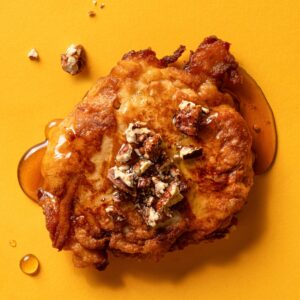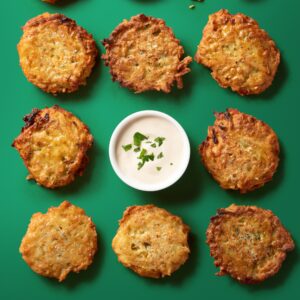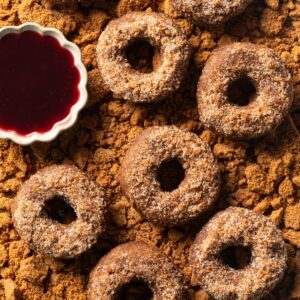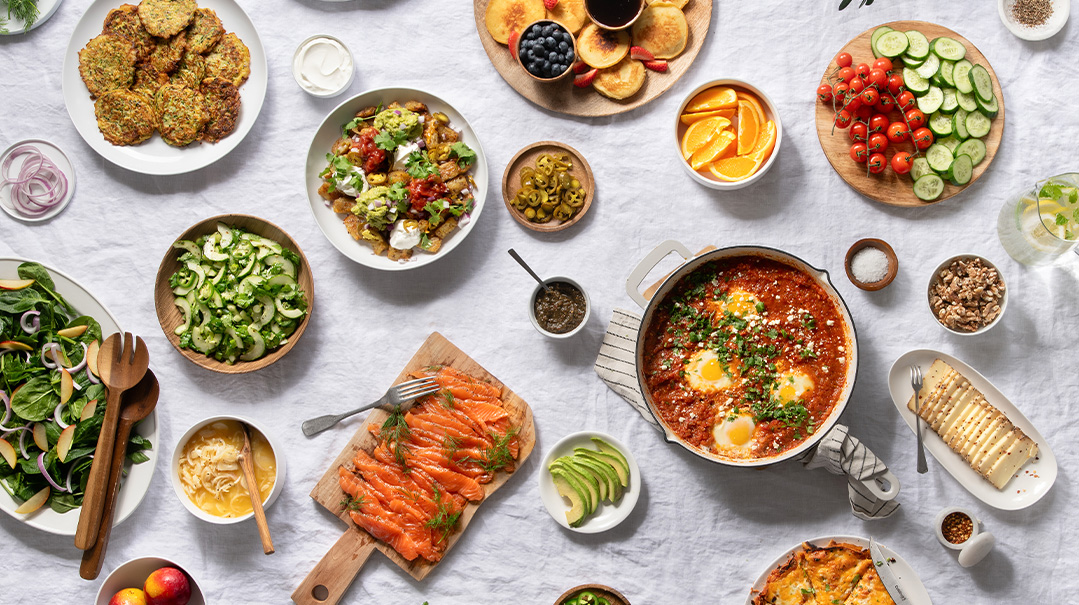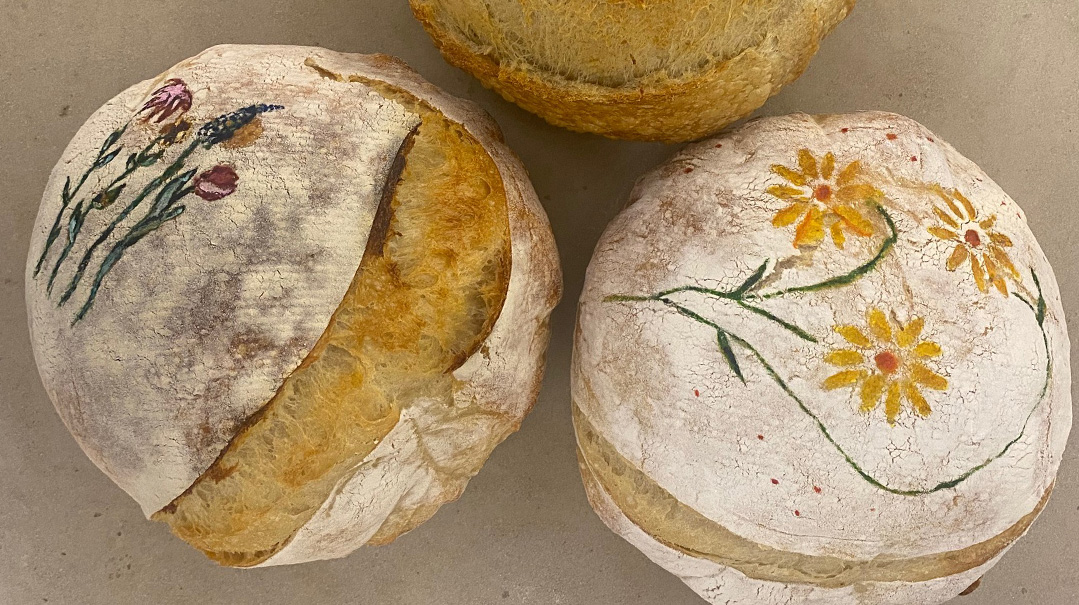Eating Your Curds and Whey
| July 26, 2022
Everyone knows if you want great apples, you go to Washington. Georgia’s pride of the farm is peaches. And for authentic (and native) cheese, Wisconsin’s your destination. So, I packed up my bags this summer and headed to America’s Dairyland to find out everything I could about this popular food group. (Full disclosure: Most of my cheese research was done sitting on my grandfather’s porch in sunny Glendale, Wisconsin, where I achieved my main summer goal — spending time with Zaidy!)
Search and Discovery
I learned the differences between ricotta, farmer cheese, and quark — and how to make each of them at home, if I were so inclined (probably not in this lifetime). I watched full-fat and reduced-fat milks bubble and curdle, harden, and then soften into creamy, fresh cheeses. I learned that temperature and acidity matter, and that milk source is everything — don’t interchange cow’s milk with goat or sheep milk unless you’re prepared for a vastly different flavor.
I was surprised to discover that muenster, one of the most popular and versatile semi-soft cheeses, was developed by French immigrants to Wisconsin in the early 1900s — around the same time my own great-grandfather emigrated there from Poland (which means we can’t claim muenster as a family legacy). Their recreation of the original French version uses annatto coloring to yield the now easily recognizable reddish orange rind.
New vs. Old, Fresh vs. Moldy
In this article we’ll cover soft and semi-soft cheeses — those that don’t need months to age, ripen, grow bacteria, or any of the other uber-cool techniques that affineurs (cheese refiners) use to produce their gourmet, funky-flavored hard cheeses. For serious foodies, high-quality fresh cheeses are best eaten within hours of making them. The rest of the world is satisfied with the grocery store variety that gives us a full two weeks to get our act together and use it up.
Soft and semi-soft cheeses are your tried-and-true buds in the kitchen — perfect for lasagna, stuffed shells, dips, sauces, spreads, and snacks. They bake beautifully into savory and sweet dishes, melt smoothly into alfredo sauces and pancake batter, and spread neatly over crackers, bagels, and veggie sticks. But do remember — all cheeses have super-high
sodium content, some containing more than the recommended daily intake per serving! So use them sparingly, and, to keep things balanced and healthy, avoid adding extra salt to dishes that contain cheese.
Here’s the lowdown on the various types, their content, uses, and a few tricks and tips for storing cheese.
Soft Cheeses
Cream cheese and cottage cheese are two of the most commonly used soft cheeses. Both are made from milk, but cream cheese retains more liquid and is blended for a smooth product. Cottage cheese is curdled and drained of excess liquid. Cream cheese typically contains higher fat and lower protein (about 5 grams per serving), while cottage cheese has less fat, fewer calories, and more protein (about 25 grams per serving).
The process for making cottage cheese involves heating milk together with an acid to curdle it. The curds (the solid, fat, and protein) then separate from the whey (the liquid). The cottage cheese is cut into large or small curds and the whey is strained out and used for other products.
Cottage cheese has high protein regardless of the fat content. Unlike milk, lower-fat cottage cheese, such as 1% or .5%, don’t have a thinner consistency, so they’re a great substitute in recipes when you want to dial down the fat without losing texture. Read your labels carefully — regular cottage cheese is 4% milkfat, reduced fat is 2%, low fat is 1% or .5%, and nonfat is anything under .5%, aka dry curd.
Whipped cottage cheese is a smoother product; it can be made at home using a food processor (works better than a blender). Whipped cottage cheese makes a great sub for cream cheese in cheesecake recipes.
Ricotta
Ricotta starts off just like cottage cheese and has similar protein content (28 grams per serving) — both consist of cooked milk with the curds and whey separated. But ricotta is made from the whey, while cottage cheese is made from the curd. Ricotta is recooked (this is actually the meaning of the word ricotta) after the whey is separated, and then strained again until a soft, dry cheese is formed. Ricotta and cottage cheese can be interchanged in more flexible recipes such as dips and spreads, but since their water content is very different, stick to the listed ingredient with baking recipes.
Farmer Cheese
There are two types of farmer cheese — European and American. This cheese is made by bringing milk to a souring point so that it coagulates, and that’s where the different continents do their own shtick: Europeans transfer the thickened milk to a sack and let it drain, yielding a smooth, creamy soft cheese. American farmers cut it into curds and then drain and press it, yielding a drier, firmer cheese.
Quark
Often interchanged with farmer cheese, quark is a curd-free, smooth, and creamy soft cheese with a lower water content than cottage cheese, similar to farmer and ricotta, but less grainy. In Israel, this cheese is common in dairy recipes and is referred to as gevina levana. If you need to sub ricotta for quark (or gevina levana), mix two parts ricotta with one part yogurt or sour cream to obtain the most similar consistency.
Semi-Soft Cheeses
Muenster
[Close your eyes and spell muenster — did you get it right? If you didn’t notice the u before the e, you haven’t earned your quiche! This was an eye-opener, even for a word-nerd like me.]
Authentic French munster is soft, aged cheese with a high fat content (close to 50%) made from unpasteurized cow’s milk, with a tangy rind that protects the cheese and gives it that signature scent and flavor. The Wisconsin version — muenster — is more common in the US. This soft cheese is unaged and doesn’t go through a rind-washing. Muenster melts like a dream into sauces and on bread and pasta, is mild in flavor, and adds a rich umami kick to any dish.
Mozzarella: Fresh and Shredded
This well-known and well-loved cheese hails from Italy, and in its most authentic form appears as a snow-white lumpy ball. Slices of fresh mozzarella are a gourmet addition to salads, pizza, or soups, and add a mild but rich flavor and texture. Shredded mozzarella is a more processed cheese product, with lower moisture and a longer shelf life, and a pale-
yellow coloring. It’s made by souring fresh mozzarella and then drying it and shredding it. Shredded mozzarella’s lower moisture content makes for a cheese that browns better and gives your food that appetizing melted cheese stretch. Mozzarella (and muenster) provides about 7-8 grams of protein per serving.
Feta
While the other cheeses mentioned here are made from cow milk, “real” feta is made from sheep milk and may contain a small percentage of goat milk. This soft, crumbly cheese is stored in a brine and adds a salty tang to salads, quiches, and other savory dishes. Used heavily in Mediterranean dishes, feta’s origins trace back to Greece, and many Greek meals include the salty cheese.
Researching the origins and varieties of cheese can put a few solid cravings and menu ideas into an author’s mind, but the irony for me is that several years ago I switched to using mostly plant-based cheeses made from nuts and soy. The jury is still out on what’s healthier — authentic cheeses with just a few pure ingredients or the more processed vegan cheeses. My verdict is to have balance in your diet as in all things, and do what works for you and your family. For every type of cheese, there is a season. And the Nine Days may just be the time when I choose to enjoy more of the dairy variety. Whatever you choose, cook it with intention and love and enjoy the process — and, oh yeah, say cheese!
How to Safely Store Soft Cheese
Soft cheeses such as fresh mozzarella should not be stored in plastic, which doesn’t allow the cheese to breathe (poor thing). Instead, wrap in parchment paper (a porous surface) and then place into an airtight container. It’s best to avoid freezing fresh mozzarella, as this can change its consistency and impact the flavor. It’s called fresh for a reason — buy what you need, and eat or share within the time frame: typically, 4–6 weeks unopened, or 4–5 days once opened.
Cheeses that soak in brine, like feta, can be left in their original packaging (many Israeli feta brands come in a handy basket that lifts up to give you just the cheese, not the brine). If you need to move this type of cheese to a different container, you can make your own brine by mixing sea salt and water, changing the brine every few days for best results.
If your soft cheese starts to grow mold, toss the whole piece or container. Unlike hard cheese, where mold may impact only one section, soft cheese mold will grow and spread quickly.
Got Cheeseboard Leftovers?
Don’t be tempted to create a smaller replica at a future event. Cheeses that have sat out for a few hours — whether soft or hard — will lose flavor and quality and are best repurposed in a dish that will be cooked or baked, such as in a sauce.
(Originally featured in Family Table, Issue 803)
Oops! We could not locate your form.

